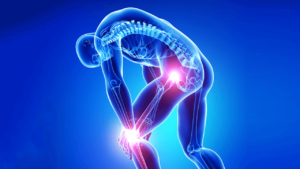
- A wrong move in the household, during leisure time, or stressful bad posture in everyday work – sooner or later most people will get to know this situation call joint pain.
- Strains or sprains with muscle and joint pain can be the result.
- This pain can occur in different parts of the body and feel different. Here’s how to treat and relieve them.
Knee and hip pain
Knee pain can have a variety of causes, including sprains, strains, bruises, tears, and in some cases, fractures. Symptoms of an injury to the knee include:
- swelling
- Pains
- Joint laxity (feeling loose in the joint)
- inability to straighten the leg
- pain behind the kneecap
Hip pain can also have many causes, including injuries. Symptoms of hip problems include:
- groin pain
- Pain in thigh or knee
- Stiffness or a feeling of a limited range of motion
- Pain when carrying loads
Knee, hip and joint pain should be evaluated by your doctor, who can identify the cause and recommend the appropriate treatment.
Shoulder and neck pain
Shoulder pain is a common type of pain that resides deep in the joint. They usually occur in the back and/or front of the shoulder, as well as in the upper part of the arm. They can have a variety of causes, including:
- Injury or sprain (blunt trauma)
- Problems in other parts of the body that radiate pain
- Injuries from physical labor, sports, or repetitive motion
- Bad posture
- Lack of exercise (e.g. after an injury)
The neck is a very mobile part of the body and supports the head. A tight neck or stiff neck can be painful. Poor posture and injuries are common causes of neck pain.
Back pain:
The Back Pain Study 2003/2006 revealed that up to 85% of the population will experience low back pain at least once in their lives.
Common causes of acute back pain are:
- lifting injuries
- Awkward movements
- Too little movement
- Bad posture
- overweight
- Muscle tension (e.g. caused by stress)
Sprains and strains
Sprains and strains are soft tissue disorders that affect the muscles, tendons, and ligaments. Strains in ligaments, muscles, or tendons are usually caused by a fall, twisting, or overstretching. Symptoms include pain such as muscle aches, muscle spasms, and muscle weakness.
Sprains, on the other hand, are caused by stretching and sometimes the tearing of ligaments. Typical symptoms are pain, bruising, swelling and inflammation such as muscle inflammation, which can limit the mobility of a limb or joint.
Prevention of muscle and joint pain
Minimize the risk of accidental injury by using safe lifting techniques, wearing equipment and protective clothing appropriate for the job being performed, and avoiding trip hazards. If you are over 45 years old, are overweight, or have had muscle or joint injuries in the past, you should have regular check-ups with your doctor to rule out any medical conditions.
HOW CAN YOU RELIEVE MUSCLE AND JOINT PAIN?
- Try an anti-inflammatory drug such as AVN Lumbaton Plus Soft Gel Capsules. Over-the-counter pain relievers can help relieve muscle pain or joint pain for up to 24 hours
- Rest and give injuries time to heal
- Apply a cold compress to the sprain or strain for 10 minutes every 1 to 2 hours for the first 48 hours after the injury
- If possible, apply compression for strains or sprains for the first 48 hours after injury. Elevate the injured area and support it with a pillow to reduce swelling
- If in doubt, consult your doctor
WHAT SHOULD YOU AVOID FOR MUSCLE AND JOINT PAIN?
- Avoid heat applications or massages for the first few days after a muscle strain or injury
- Don’t rush back into your workout. While exercise is important to help injured muscles heal, it should only be done in consultation with your doctor or physical therapist, as they can determine the optimal time
How Nurofen with the active ingredient ibuprofen can help with muscle and joint pain
In the case of muscle pain and joint pain caused by a sprain, strain, or bruise, such as bruised knees, sprained ankles, etc., inflammatory processes take place in the muscle tissue. Ibuprofen, the active ingredient in Nurofen, helps reduce inflammation and pain. Nurofen reduces pain and inflammation and is available in various dosage forms, such as tablets, juices, or pain patches.
Systemic agents such as tablets or juices are distributed throughout the body via the blood or lymphatic system. The effect accordingly affects the entire organism or body.
The topical application of a drug means that an active ingredient is applied only to the site of pain where it is intended to act. This can reduce the risk of side effects in other areas of the body.
The Nurofen 24-hour pain patch is applied topically and provides long-lasting and effective relief from muscle and joint pain. It can be used in adults and adolescents 16 years and older for the short-term, symptomatic treatment of localized pain associated with acute strains and near the joints of sprained limbs following blunt trauma. It achieves its pain-relieving effect due to the proven painkiller ibuprofen it contains – up to 24 hours with just one application. The Nurofen 24-hour pain patch offers a stronghold, even in difficult areas. It is wafer-thin, flexible, and discreet as well as well tolerated.
When should you seek medical help?
See a doctor if your pain is severe, the result of an injury, or if you are concerned.
Don’t delay seeing a doctor if your pain persists or worsens, or if you have other symptoms.
